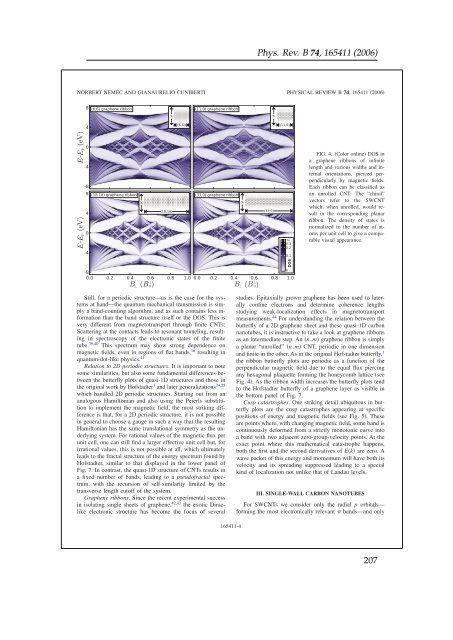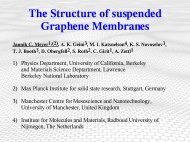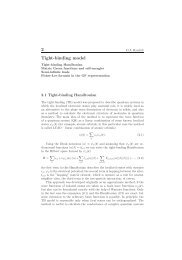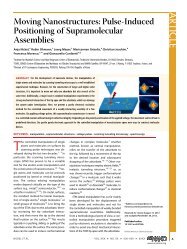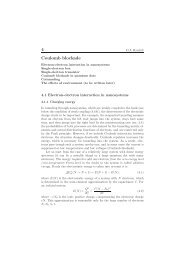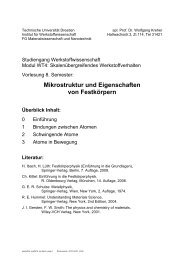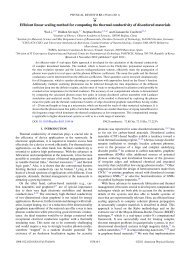online .pdf paper (for personal use only) - Chair of Materials Science ...
online .pdf paper (for personal use only) - Chair of Materials Science ...
online .pdf paper (for personal use only) - Chair of Materials Science ...
You also want an ePaper? Increase the reach of your titles
YUMPU automatically turns print PDFs into web optimized ePapers that Google loves.
NORBERT NEMEC AND GIANAURELIO CUNIBERTI PHYSICAL REVIEW B 74, 165411 2006<br />
Still, <strong>for</strong> a periodic structure—as is the case <strong>for</strong> the systems<br />
at hand—the quantum mechanical transmission is simply<br />
a band-counting algorithm, and as such contains less in<strong>for</strong>mation<br />
than the band structure itself or the DOS. This is<br />
very different from magnetotransport through finite CNTs:<br />
Scattering at the contacts leads to resonant tunneling, resulting<br />
in spectroscopy <strong>of</strong> the electronic states <strong>of</strong> the finite<br />
tube. 39,40 This spectrum may show strong dependence on<br />
magnetic fields, even in regions <strong>of</strong> flat bands, 16 resulting in<br />
quantum-dot-like physics. 41<br />
Relation to 2D periodic structures. It is important to note<br />
some similarities, but also some fundamental differences between<br />
the butterfly plots <strong>of</strong> quasi-1D structures and those in<br />
the original work by H<strong>of</strong>stadter 1 and later generalizations 24,25<br />
which handled 2D periodic structures. Starting out from an<br />
analogous Hamiltonian and also using the Peierls substitution<br />
to implement the magnetic field, the most striking difference<br />
is that, <strong>for</strong> a 2D periodic structure, it is not possible<br />
in general to choose a gauge in such a way that the resulting<br />
Hamiltonian has the same translational symmetry as the underlying<br />
system. For rational values <strong>of</strong> the magnetic flux per<br />
unit cell, one can still find a larger effective unit cell but, <strong>for</strong><br />
irrational values, this is not possible at all, which ultimately<br />
leads to the fractal structure <strong>of</strong> the energy spectrum found by<br />
H<strong>of</strong>stadter, similar to that displayed in the lower panel <strong>of</strong><br />
Fig. 7. In contrast, the quasi-1D structure <strong>of</strong> CNTs results in<br />
a fixed number <strong>of</strong> bands, leading to a pseud<strong>of</strong>ractal spectrum,<br />
with the recursion <strong>of</strong> self-similarity limited by the<br />
transverse length cut<strong>of</strong>f <strong>of</strong> the system.<br />
Graphene ribbons. Since the recent experimental success<br />
in isolating single sheets <strong>of</strong> graphene, 42,43 the exotic Diraclike<br />
electronic structure has become the focus <strong>of</strong> several<br />
165411-4<br />
Phys. Rev. B 74, 165411 (2006)<br />
FIG. 4. Color <strong>online</strong> DOS in<br />
a graphene ribbons <strong>of</strong> infinite<br />
length and various widths and internal<br />
orientations, pierced perpendicularly<br />
by magnetic fields.<br />
Each ribbon can be classified as<br />
an unrolled CNT: The “chiral”<br />
vectors refer to the SWCNT<br />
which, when unrolled, would result<br />
in the corresponding planar<br />
ribbon. The density <strong>of</strong> states is<br />
normalized to the number <strong>of</strong> atoms<br />
per unit cell to give a comparable<br />
visual appearance.<br />
studies. Epitaxially grown graphene has been <strong>use</strong>d to laterally<br />
confine electrons and determine coherence lengths<br />
studying weak-localization effects in magnetotransport<br />
measurements. 44 For understanding the relation between the<br />
butterfly <strong>of</strong> a 2D graphene sheet and these quasi-1D carbon<br />
nanotubes, it is instructive to take a look at graphene ribbons<br />
as an intermediate step. An n,m graphene ribbon is simply<br />
a planar “unrolled” n,m CNT, periodic in one dimension<br />
and finite in the other. As in the original H<strong>of</strong>stadter butterfly, 1<br />
the ribbon butterfly plots are periodic as a function <strong>of</strong> the<br />
perpendicular magnetic field due to the equal flux piercing<br />
any hexagonal plaquette <strong>for</strong>ming the honeycomb lattice see<br />
Fig. 4. As the ribbon width increases the butterfly plots tend<br />
to the H<strong>of</strong>stadter butterfly <strong>of</strong> a graphene layer as visible in<br />
the bottom panel <strong>of</strong> Fig. 7.<br />
Cusp catastrophes. One striking detail ubiquitous in butterfly<br />
plots are the cusp catastrophes appearing at specific<br />
positions <strong>of</strong> energy and magnetic fields see Fig. 5. These<br />
are points where, with changing magnetic field, some band is<br />
continuously de<strong>for</strong>med from a strictly monotonic curve into<br />
a band with two adjacent zero-group-velocity points. At the<br />
exact point where this mathematical catastrophe happens,<br />
both the first and the second derivatives <strong>of</strong> Ek are zero. A<br />
wave packet <strong>of</strong> this energy and momentum will have both its<br />
velocity and its spreading suppressed leading to a special<br />
kind <strong>of</strong> localization not unlike that <strong>of</strong> Landau levels.<br />
III. SINGLE-WALL CARBON NANOTUBES<br />
For SWCNTs we consider <strong>only</strong> the radial p orbitals—<br />
<strong>for</strong>ming the most electronically relevant bands—and <strong>only</strong><br />
207


